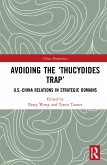Graeme D. Ruxton (Professor, Professor, University of St Andrews, U, William L. Allen (Lectur Lecturer in the Department of Biosciences, Thomas N. Sherratt (Professor, Professor, Carleton University, Cana
Avoiding Attack
The Evolutionary Ecology of Crypsis, Aposematism, and Mimicry
Graeme D. Ruxton (Professor, Professor, University of St Andrews, U, William L. Allen (Lectur Lecturer in the Department of Biosciences, Thomas N. Sherratt (Professor, Professor, Carleton University, Cana
Avoiding Attack
The Evolutionary Ecology of Crypsis, Aposematism, and Mimicry
- Gebundenes Buch
- Merkliste
- Auf die Merkliste
- Bewerten Bewerten
- Teilen
- Produkt teilen
- Produkterinnerung
- Produkterinnerung
This book discusses the mechanisms by which prey avoid predator attacks, and how such mechanisms have evolved through natural selection.
Andere Kunden interessierten sich auch für
![Avoiding Drink and Drugs Avoiding Drink and Drugs]() Louise SpilsburyAvoiding Drink and Drugs16,99 €
Louise SpilsburyAvoiding Drink and Drugs16,99 €![Avoiding Common Anesthesia Errors Avoiding Common Anesthesia Errors]() Catherine MarcucciAvoiding Common Anesthesia Errors87,99 €
Catherine MarcucciAvoiding Common Anesthesia Errors87,99 €![From Conflict to Courage: How to Stop Avoiding and Start Leading From Conflict to Courage: How to Stop Avoiding and Start Leading]() Marlene ChismFrom Conflict to Courage: How to Stop Avoiding and Start Leading17,99 €
Marlene ChismFrom Conflict to Courage: How to Stop Avoiding and Start Leading17,99 €![Avoiding Drink and Drugs Avoiding Drink and Drugs]() Louise SpilsburyAvoiding Drink and Drugs10,99 €
Louise SpilsburyAvoiding Drink and Drugs10,99 €![Dinosaur Club: Avoiding the Allosaurus Dinosaur Club: Avoiding the Allosaurus]() Rex StoneDinosaur Club: Avoiding the Allosaurus8,99 €
Rex StoneDinosaur Club: Avoiding the Allosaurus8,99 €![Avoiding War with China: Two Nations, One World Avoiding War with China: Two Nations, One World]() Amitai EtzioniAvoiding War with China: Two Nations, One World16,99 €
Amitai EtzioniAvoiding War with China: Two Nations, One World16,99 €![Avoiding the 'Thucydides Trap' Avoiding the 'Thucydides Trap']() Avoiding the 'Thucydides Trap'191,99 €
Avoiding the 'Thucydides Trap'191,99 €-
-
-
This book discusses the mechanisms by which prey avoid predator attacks, and how such mechanisms have evolved through natural selection.
Produktdetails
- Produktdetails
- Verlag: Oxford University Press
- 2 Revised edition
- Seitenzahl: 304
- Erscheinungstermin: 17. Oktober 2018
- Englisch
- Abmessung: 251mm x 195mm x 20mm
- Gewicht: 850g
- ISBN-13: 9780199688678
- ISBN-10: 0199688672
- Artikelnr.: 53020770
- Verlag: Oxford University Press
- 2 Revised edition
- Seitenzahl: 304
- Erscheinungstermin: 17. Oktober 2018
- Englisch
- Abmessung: 251mm x 195mm x 20mm
- Gewicht: 850g
- ISBN-13: 9780199688678
- ISBN-10: 0199688672
- Artikelnr.: 53020770
Graeme Ruxton is Professor of Evolutionary Ecology at the University of St Andrews, Scotland. He has broad interests in behavioural ecology, but mostly focusses on predator-prey interactions. His main means of investigation is in various types of theoretical modelling, but this is generally linked to empirical data collection in the field or laboratory. His interests are wide in terms of ecosystems and taxonomy too, and he has occasionally published speculations on the ecologies of extinct species. Graeme's interest in predator-prey interactions has grown to include between-species communication more generally and he has a strong interest in how plants interact with animal antagonists and mutualists. William Allen is an evolutionary ecologist who investigates antipredator defences at macroecological and macroevolutionary scales. His interdisciplinary training at the University of Bristol in human, animal, and machine vision has allowed him to apply novel techniques to understanding the visual ecology of defences in diverse taxa, including felids, reptiles, and ungulates. Other research interests include intraspecific visual signalling in primates and life history evolution. He currently teaches courses on sensory ecology and the evolution of tetrapods. Tom Sherratt has a broad range of interests in the fields of behavioural and evolutionary ecology, notably predator-prey interactions, the evolution of senescence and the evolution of cooperation. Members of the Sherratt lab conduct both field and laboratory experiments, but they also attempt to develop and test biologically relevant theory. Tom also teaches courses in statistics and computer modelling. Michael Speed is an evolutionary biologist with longstanding interests in predator-prey relationships, evolution, and phylogenetics. He studied at Leeds University, where he began his work on the evolution of signalling in mimicry systems and currently lectures in evolution and behaviour at the University of Liverpool, where he is also Head of the School of Life Sciences.
Introduction
Chapter summary
The sequence of a predator-prey encounter and investment across multiple defences
1: Background matching
2: Disruptive camouflage
3: Countershading
4: Transparency
5: Secondary defences
6: Aposematism
7: Müllerian mimicry
8: Advertising elusiveness
9: Batesian mimicry and masquerade
10: Startling predators
11: Deflecting the point of attack
12: Dazzle camouflage
13: Thanatosis
14: Synthesis
Chapter summary
The sequence of a predator-prey encounter and investment across multiple defences
1: Background matching
2: Disruptive camouflage
3: Countershading
4: Transparency
5: Secondary defences
6: Aposematism
7: Müllerian mimicry
8: Advertising elusiveness
9: Batesian mimicry and masquerade
10: Startling predators
11: Deflecting the point of attack
12: Dazzle camouflage
13: Thanatosis
14: Synthesis
Introduction
Chapter summary
The sequence of a predator-prey encounter and investment across multiple defences
1: Background matching
2: Disruptive camouflage
3: Countershading
4: Transparency
5: Secondary defences
6: Aposematism
7: Müllerian mimicry
8: Advertising elusiveness
9: Batesian mimicry and masquerade
10: Startling predators
11: Deflecting the point of attack
12: Dazzle camouflage
13: Thanatosis
14: Synthesis
Chapter summary
The sequence of a predator-prey encounter and investment across multiple defences
1: Background matching
2: Disruptive camouflage
3: Countershading
4: Transparency
5: Secondary defences
6: Aposematism
7: Müllerian mimicry
8: Advertising elusiveness
9: Batesian mimicry and masquerade
10: Startling predators
11: Deflecting the point of attack
12: Dazzle camouflage
13: Thanatosis
14: Synthesis








